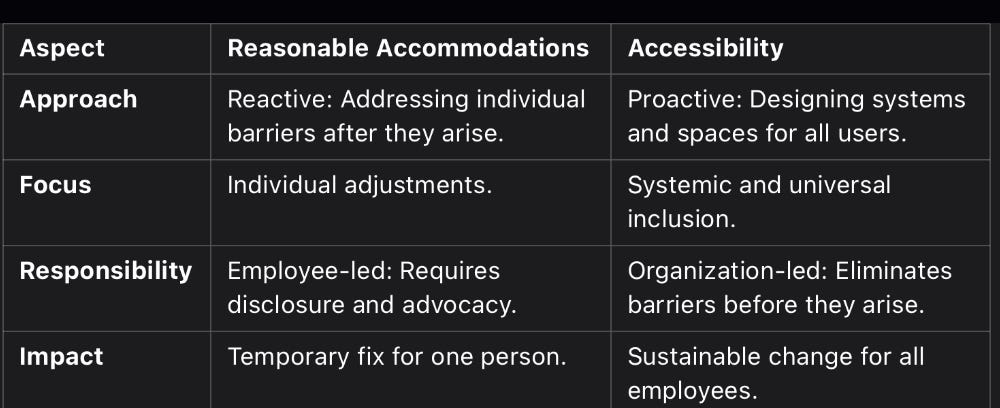Too often, conversations about disability inclusion in organizations center on “reasonable accommodations” or “special accommodations.” While these terms and practices meet legal requirements and address individual needs, they are often rooted in ableism, reinforcing the idea that disabled individuals are exceptions who require special treatment. This reactive mindset creates barriers, stigmatizes employees with disabilities, and overlooks the transformative power of proactive accessibility and disability justice.
True inclusion requires shifting from accommodations to accessibility—a systemic, justice-driven approach that creates equitable environments by design. This shift not only benefits disabled employees but strengthens organizational health, enhances culture, and drives innovation.
The Roots of Ableism in Accommodations
What Are Reasonable or Special Accommodations?
Reasonable accommodations are individualized modifications provided to employees with disabilities to enable them to perform their essential job functions. These adjustments—such as flexible schedules, screen readers, or ergonomic furniture—are often made upon request, as required by laws like the Americans with Disabilities Act (ADA).
While essential, accommodations often reflect and reinforce ableist systems by:
1. Positioning disability as a “problem” requiring individual solutions.
2. Placing the burden on employees to disclose disabilities, request changes, and justify their needs.
3. Treating accessibility as an exception rather than a standard.
What Is Accessibility?
Accessibility is proactive and systemic. It involves designing environments, systems, and policies to be inclusive for all people, regardless of ability, from the outset. Accessibility is a cornerstone of disability justice, which centers equity, intersectionality, and systemic transformation.
Accessibility benefits everyone. It reduces barriers for disabled employees while creating environments where all employees—regardless of ability, background, or identity—can thrive.
Why This Shift Matters
Ableism Undermines Equity and Inclusion
Ableism is not just cultural; it’s deeply embedded in organizational systems and practices. Relying solely on accommodations perpetuates inequities by:
• Reinforcing exclusion: Accommodations address individual needs but fail to challenge systemic barriers that exclude others.
• Placing undue burden: Disabled employees are required to advocate for themselves, often at great emotional and professional cost.
• Maintaining reactive systems: Organizations waste resources by responding to barriers as they arise, rather than eliminating them proactively.
Accessibility: The Foundation of Disability Justice
Disability justice, developed by BIPOC disability activists such as Mia Mingus and Patty Berne, emphasizes interdependence, equity, and systemic change. Accessibility aligns with these principles, shifting the focus from individual fixes to collective accountability.
Accessibility is not just an accommodation for the few; it is an act of justice for all.
The Impact of Accessibility on Organizational Health
Organizations that prioritize accessibility create workplaces where all employees can thrive. Key benefits include:
1. A Thriving Workforce
Proactive accessibility sends a clear message: You belong here. Employees who feel included and valued experience higher engagement, productivity, and loyalty.
2. Enhanced Culture of Inclusion
Accessibility dismantles ableist norms and fosters collaboration, empathy, and interdependence. It creates a shared responsibility for inclusion, shifting organizational mindsets and behaviors.
3. Operational Excellence
Accessible systems—such as universally designed tools, workflows, and spaces—save time and resources. Proactive design minimizes the need for retroactive fixes, making organizations more efficient.
4. Intersectional Inclusion
Accessibility benefits everyone, especially those with intersecting marginalized identities (e.g., disabled BIPOC or LGBTQ+ employees). It fosters equity across the board, building a resilient and inclusive workplace culture.
Strategies to Shift From Accommodations to Accessibility
1. Conduct a Systemic Anti-Ableism Audit
Assess policies, systems, spaces, and practices for ableist assumptions. Include disabled employees in the process, compensating them for their expertise.
• Example: Audit hiring practices for implicit ableism, such as inaccessible application portals or biased interview questions.
2. Build Accessibility Into Leadership Accountability
Train leaders to recognize and dismantle ableism in decision-making, and hold them accountable for measurable accessibility outcomes.
• Example: Embed accessibility goals into leadership performance evaluations and DEI strategies.
3. Design for Universal Inclusion
Adopt universal design principles to create systems and environments usable by everyone, without the need for adaptations.
• Example: Provide captions for all meetings by default, ensuring they’re accessible to employees with hearing impairments, non-native speakers, or those in noisy environments.
4. Center Disability Justice in DEI Initiatives
Disability is often overlooked in diversity, equity, and inclusion (DEI) efforts. Commit to centering disability justice as an integral component of organizational equity.
• Example: Partner with disability-led organizations to co-create accessibility initiatives and training programs.
5. Normalize Accessible Practices
Accessibility should not be a special request—it should be embedded into organizational culture and daily operations.
• Example: Ensure all internal and external communications are accessible, including digital content, presentations, and events.
6. Create Transparent Feedback Loops
Establish systems where employees can provide anonymous feedback on accessibility barriers without fear of retaliation. Use this feedback to drive continuous improvement.
• Example: Launch an accessibility task force and publish progress metrics to ensure accountability.
Reasonable Accommodations vs. Accessibility: A Paradigm Shift
To illustrate the difference between accommodations and accessibility:
A Call to Action: Building Accessible and Just Organizations
Reasonable accommodations may meet the legal minimum, but they cannot create thriving organizations. Accessibility and disability justice go far beyond compliance—they challenge ableist norms, foster equity, and build environments where all employees can thrive.
To shift from accommodations to accessibility, organizations must:
• Acknowledge the ableist foundations of current systems.
• Center the voices and expertise of disabled employees and advocates.
• Commit to proactive, intersectional strategies that transform barriers into pathways.
Accessibility is not just about removing obstacles; it’s about reimagining workplaces as equitable, inclusive communities where belonging is the norm. Organizations that prioritize accessibility are better positioned to innovate, adapt, and succeed in today’s rapidly evolving world.
The question is no longer why accessibility matters, but when you will take action. Let accessibility and disability justice become the pillars of your organization’s health and future.
Your move: Will your organization settle for reactive inclusion, or will you lead the way with accessibility and justice?
Follow “ACCESS Points” for more strategies on fostering accessible, inclusive, and thriving organizations.



